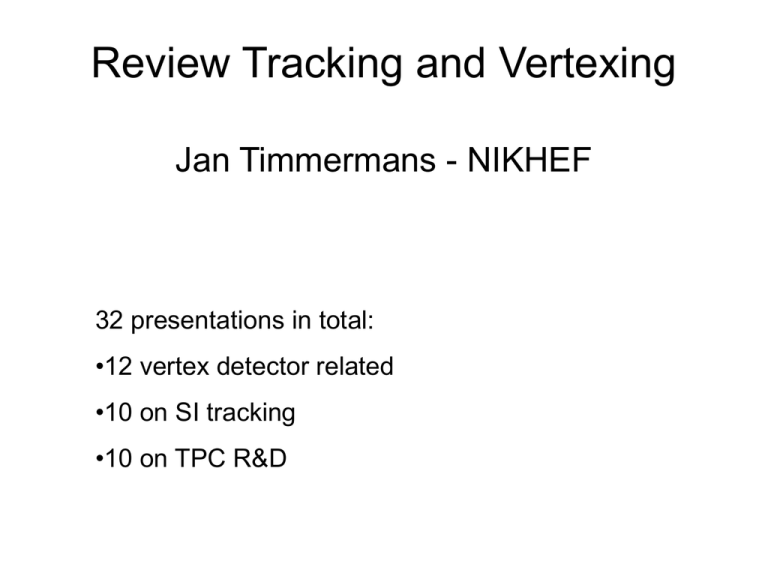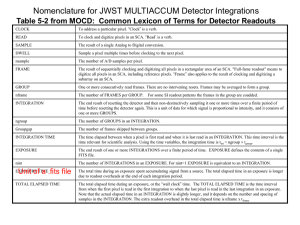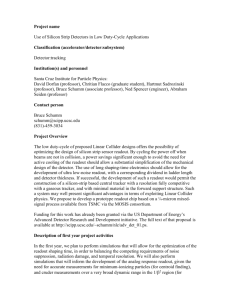Tracking and Vertexing
advertisement

Review Tracking and Vertexing Jan Timmermans - NIKHEF 32 presentations in total: •12 vertex detector related •10 on SI tracking •10 on TPC R&D Physics Inclusive Higgs: Z Recoil mass H Branching Ratios Smuon pair-production 2 Basic design concept • Performance goal (common to all det. concepts) – Vertex Detector: ( IP ) 5 10 / p sin – Tracking: pt / pt 5 10 – Jet energy res.: 2 3/ 2 5 E / E 0.3 / E Detector optimized for Particle Flow Algorithm (PFA) 3 SiD LDC GLD 4 Comparison of parameters: Solenoid Main Tracker B(T) R(m) L(m) Est(GJ) Rmin (m) Rmax(m) s(mm) Nsample s(1/pt) SiD 5 LDC 4 GLD 3 2.48 5.8 1.4 3.0 9.2 2.3 3.75 9.86 1.8 0.2 1.25 0.36 1.62 0.4 2.0 7 5 3.6e-5 150 200 1.5e-4 150 220 1.2 e-4 5 Vertex Detector •pixels ~ 20 x 20 μm2 •point resolution ~3 μm •material <0.1% X0 •1st layer at ~1.5 cm To keep occupancy below 1%: •readout ~20 times during bunch train or store signals •OR make pixels smaller ( FPCCD 5 x 5 μm2 ) 6 Many variants: CPCCD, FPCCD, DEPFET, MAPS, FAPS, SoI, ISIS New at LCWS05: •(revolver)ISIS •Add time stamping (Baltay, Bashindzhagyan) 7 CPCCD, (revolver)ISIS (K. Stefanov - LCFI) •CPC1: 750x400 pixels, 20x20 μm2 •Bump bonded by VTT to readout CPR1 •Clocked at 25 MHz •Various sized (up to 92mmx15mm) CPC2 detector chips +ISIS chips in production 8 ISIS R&D RF pickup is a concern for all sensors converting charge into voltage during the bunch train; The In-situ Storage Image Sensor (ISIS) eliminates this source of EMI: Charge collected under a photogate; Charge is transferred to 20-pixel storage CCD in situ, 20 times during the 1 ms-long train; Conversion to voltage and readout in the 200 ms-long quiet period after the train, RF pickup is avoided; 1 MHz column-parallel readout is sufficient; 9 Revolver ISIS 4 5 Storage gate 3 6 Storage gate 2 RSEL OD RD RG 1 7 8 OS Output node to column load Output gate Photogate Transfer gate 8 20 19 Charge Storage generation Transfer 18 17 Idea by D. Burt and R. Bell (E2V) Readback from gate 6 Vertex Detector Options • FPCCD Y.Sugimoto - KEK – Accumulate hit signals for one train and read out between trains – Keep low pixel occupancy by increasing number of pixels by x20 with respect to “standard” pixel detector – As a result, pixel size should be as small as ~5x5mm2 – Epitaxial layer has to be fully depleted to minimize charge spread by diffusion – Operation at low temperature to keep dark current negligible (r.o. cycle=200ms) Tracking efficiency under beam background is critical issue; simulation needed. 11 DEPFET (M. Trimpl) – Bonn, Mannheim, MPI MIP sourcetop gate p clear bulk p+ n+ n+ ------ + -+ + + n • small pixels 20-30µm • radiation tolerance (>200krad) internal gate 50 µm n+ p+ drain n - p+ back contact charge collection in fully depleted substrate • low noise • thin devices (50µm) S/N = 40 • low power (row-wise operation) • fast readout (cold machine), 50MHz line rate • zero suppressed data •FET transistor in every pixel (first amplification) •Electrons collected at internal gate modulate the transistor current. Signal charge removed via CLEAR •No charge transfer •Low power consumption: ~5W for full VXD 12 ILC-DEPFET system Gate Switcher Reset Switcher CURO II 13 Testbeam: Setup Testbeam 24 @ DESY Jan + Feb 2005 3 x 3 mm2 Scintillator DEPFET TelescopeScintillator System Module 14 The Active DEPFET Pixel Sensor: Irradiation Effects due to Ionizing Radiation L. Andricek Irradiated with 60Co gammas up to 912 krad 912 krad Acceptable small shift in threshold voltages (for 6 DEPFETs) Flexible APS J. Velthuis – UK MAPS FAPS Memory Cell #0 RST_W • FAPS=Flexible APS – Every pixel has 10 deep pipeline • Designed for TESLA proposal. – Quick sampling during bunch train and readout in long period between bunch trains Column Output Memory Cell #1 1 A Write amplifier Memory Cell #9 SEL Ibias •S/N between 14.7 and 17.0 16/20 Performances Achieved with MIMOSA chips • 11 MIMOSA prototypes designed and fabricated since 1999 • 6 fabrication processes explored: AMS-0.6mm, AMI-0.35mm, AMS-0.35mm (opto and ordinary), IBM-0.25mm, TSMC-0.25mm • Most chips tested with ~102 GeV/c (CERN-SPS) – S/N ~ 20-30 (MPV) det ~ 99-99.9 % – ssp = 1.5-2.5 mm (20 mm pitch) ; s2hits ≥~ 30 mm – Rad. Tol. For ILC conditions checked with neutrons and X-Rays – Reticle size chip fabricated and working well (e.g. imager) – Assessment of 50 mm thinning under way • Application to STAR, CBM, etc. M. Winter - Strasbourg 17 Summary and Outlook • • Concept of vertex detector using features of CMOS sensors progressing, based on requirements accounting for uncertainties (eBS !) Well established performances: • Most recent achievements • – S/N, det, ssp – Rad. Tolerance to neutrons and X-Rays – 120 mm thinning of Megapixel sensors – Fast col. // pixel architecture (integrated CDS) found, with low noise (< 20 e- ENC) and small pixel-to-pixel dispersion – Assessment of a well performing R&D fabrication process: AMS-035 mm (opto and epi-free) very good perfo. even with 40 mm pitch (L4) – Checks of tolerance to 10-20 MeV electrons under way – Outcome of thinning to 50 mm under study (≥~ 15 mm not yet OK) Next important steps: 1) Fast column // sensor with digital output, adapted to L0-1 (integrated low power, fast and compact 4-bit ADC) 2) New multi-memory cell sensor adapted to L2-4 – Complete study of MIMOSA-5 thinning to ~ 50 mm with LBL – Investigate characteristics of new fab. processes (e.g. IBM-0.13 mm, UMC-0.18 mm) Thinning no-epi sensors is very appealing: any possibility ? Privileged contact with a foundry would be very valuable… Aim for a fast col. // megapixel proto providing digital output in 2007 18 D. Contarato - DESY 19 Monolithic CMOS Pixel Detectors Big Pixels 50µ x 50µ C. Baltay Small Pixels 5µ x 5µ Two active particle sensitive layers: After selecting hits in same bunch: occupancy ~10-6 Big Pixels – High Speed Array – Hit trigger, time of hit Small Pixels – High Resolution Array – Precise x,y position, intensity 20 Array Designs High-speed arrays High-resolution arrays Designed for quick response. Designed for resolution and – Threshold detection only. – Large pixels (~50 x 50 mm). Transmits X,Y location and time stamp of impact. querying. – Smaller pixel size (~5 x 5 mm). – Random access addressability. – Records intensity. Provides intensity information only for pixel region queried. Contact Pads Pixel Array Contact Pads Pixel Array 21 A. Bulgheroni - Como Principle of SOI monolithic detector Integration of the pixel detector and readout electronics in a waferbonded SOI substrate Detector handle wafer Connection between pixel and readout channel High resistive (> 4 kcm,FZ) 400 mm thick Conventional p+-n Electronics active layer Low resistive (9-13 cm, CZ) 1.5 mm thick Standard CMOS technology 22 First large-scale SOI Detectors Fully functional detectors with implemented readout blocks on chip 128 x 128 readout channels area 2.4 cm x 2.4 cm 4 independent sub-matrices Operation in charge integration mode Dead time below 1% with respect to integration time SOI detector 128x128 channels, integrated control blocks Optimised for medical applications Backup SOI detector 48x48 channels Xilinx XC95288 „Baby Detector” – 48 x 48 readout channels, area 1.2 cm x 1.2 cm, no digital control blocks Column, row and reset signals generated by Xilinx CPLD (XC95288XL) 23 Si Tracking T.Nelson 24 25 Design of the SiD Silicon Tracker • • Support of barrels and disks is based upon sandwiches of carbon fiber (epoxy) – Rohacell – carbon fiber (epoxy). Barrel lengths vary with radius to allow disks to be inset. – • The Victoria design assumed: – – – • Barrels of uniform lengths with disks at ends are also under consideration. Single-sided sensors No stereo in the barrels and approximately 90o stereo in the disks Forced air cooling, which implies that readout chip power must be cycled. Simulation studies are in progress to understand the number of barrels and disks, and the number of stereo layers, needed. X0 (%) versus cos(θ) (VXD and beam pipe are not included) Outer silicon tracker and VXD Material Budget 20.00 X0 (%) 18.00 16.00 14.00 12.00 10.00 8.00 6.00 4.00 2.00 0.00 0.000 0.200 0.400 0.600 0.800 1.000 Cos() Bill Cooper 26 Modifications to the Design • • • Barrel lengths can be varied to redistribute material in the X0 peak at cos(θ) ≈ 0.82. Possible designs of barrel sensor module support structures have been proposed. Work to integrate the outer silicon tracker and the VXD geometries has begun. – – Provisions to service the VXD assume that the outer tracker is moved longitudinally while the VXD and beam line elements remain fixed. Disks of the outer tracker have been separated into inner and outer portions to achieve that. Inner portions would be supported from the beam pipe. Layout with barrel lengths adjusted to distribute X0 peak. Separated disk portions are shown, also. Bill Cooper Tracker opened for VXD servicing 27 Frequency Scanned Interferometer for ILC Tracker Alignment Hai-Jun Yang, Sven Nyberg, Keith Riles University of Michigan, Ann Arbor 8th International Linear Collider Workshop SLAC, March 18-22, 2005 A Possible SiD Tracker Alignment 752 point-to-point distance measurements 29 Summary and Outlook Two FSI demonstration systems, with or without optical fibers, were constructed to make high-precision absolute distance measurements. Two new multi-distance-measurement analysis techniques were presented to improve absolute distance measurement and to extract the amplitude and frequency of vibration. A high precision of ~50 nm for distances up to 60 cm under laboratory conditions was achieved. Major error sources were estimated, and the expected error was in good agreement with spread in data. We are investigating dual-laser scanning technique used by Oxford ATLAS group currently. Michigan group has extended the frontier of FSI technology, but much work lies ahead. 30 Silicon Tracking System with a central gaseous detector The Silicon Envelope concept = ensemble of Si-trackers surrounding the TPC (LC-DET-2003-013) TPC The Si-FCH: TPC to calorimetry (SVX,FTD,(TPC),SiFCH) The FTD: Microvertex to SiFCH The SIT: Microvertex to TPC Microvertex A. Savoy-Navarro The SET: TPC to calorimetry (SVX, SIT, (TPC), SET)31 Crucial Keywords: Robustness Full coverage Improved performances 30° TPC end caps 25° 7° 32 Central Outer Si layers: current design SiD explores very long microstrips or tiles In current SET design 60 cm long microstrips look OK. Applies also to outer central layers for SiD 33 Prototype chip received February 28th One analog channel UMC 0.18 mm CMOS Europractice (Leuven, Belgium) - 16 ch + 1 Preamp, Shaper, Sample & Hold, ADC Comparator - Two blocks of 1.6 x 1.6 mm2 each J.-F. Genat 34 Jean-Francois Genat, LCWS05, Stanford, March 20th 2005 Silicon 3mm 16 + 1 channel UMC 0.18 um chip (layout and picture) 35 Jean-Francois Genat, LCWS05, Stanford, March 20th 2005 Just received ! Very first preliminary results Two tested chips fully functional Preamp + Shaper Under Preamp: Gain 8mV/MIP Linearity +/-1.5% Dynamic range: 75 MIP OK OK Noise @ 3.3pF input cap, 3 ms shaping time: 205 e- 140 e- expected Shaper: 2 - 10 ms tunable peaking time OK Power: Preamp 90 mW 70 mW expected Shaper 110 mW OK 30 W full detector 36 Jean-Francois Genat, LCWS05, Stanford, March 20th 2005 Development of Double-sided Silicon Strip Detector • • • • • Introduction Electrical Test Source Test Radiation Damage Test Summary and Future Plan •Fabrication “in house” •5” wafers H. Park (BAERI, KNU) On behalf of Korean Silicon Group G.Bashindzhagyan N.Sinev LCWS 2005 Digital Active Pixel Array 25x25 μm2 G.Bashindzhagyan pixels DAP Strip 1 DAP Strip 2 Position memory Time memory Position memory Time memory Position memory Time memory Position memory Time memory Position memory Time memory Position memory Time memory 38 Digital Active Pixel Array G.Bashindzhagyan N.Sinev LCWS 2005 Pixel Structure ≥25mµ 25 µm 25 µm ≥25µm ≥25µm Sensor Sensor Sensor FF FF FF Sensor Sensor Sensor FF FF FF Serial out Parallel out Serial out Parallel out 39 Digital Active Pixel Array G.Bashindzhagyan N.Sinev LCWS 2005 Timing Diagram 950µs, 2820 bunches Bunch train Analog power Bunches i-th Sensor out i-th FF i-th FF Parallel out Analog Power Sensor FF Clock DAP Strip time memory Clock DAP Strip position memory 337ns 2820 steps 950µs 100ns DAP Strip 40 Memory TPC R&D •Gas amplification: GEM, Micromegas; compare with wires •Different gases: Ar-CH4(5%)-CO2(2%) ‘TDR’ Ar-CH4(5%,10%) P5, P10 Ar-iC4H10(5%) Isobutane Ar-CF4(2-10%) CF4 He-iC4H10(20%) Helium •Laser studies •Field cage optimisation •Mapping a large parameter space 41 Victoria Aachen DESY MPI/Asia Cornell/ Purdue 42 laser + optics laser power supply TPC holder Victoria 43 Many groups involved: •Aachen, DESY, Hamburg U., Karlsruhe, Krakow, MPIMunich, NIKHEF, BINP Novosibirsk, Orsay, Rostock U., Saclay, PNPI StPetersburg •Carleton, Berkeley, Montreal, Victoria •Chicago/Purdue, Cornell, MIT, Temple/Wayne State, Yale •Chiba U., Hiroshima, Minadamo, Kinki U., Osaka, Tokyo (4 groups), Tsukuba (2 groups) 44 Gas-Amplification Systems: GEM: Two copper foils separated by kapton, multiplication takes place in holes, uses 2 or 3 stages Wires & MPGDs Micromegas: micromesh sustained by 50μm pillars, multiplication between anode and mesh, one stage P~140 μm D~60 μm S1/S2 ~ Eamplif / Edrift S1 S2 45 Double track fits: 2mm wide pads s = 0.5 mm D. Karlen Dx = 3.8 mm dips between tracks Dx = 2.0 mm no dips 46 Micromegas:Diameter 50 cm Saclay 47 Charge spreading through resistive foil; can still use ‘wider’ pads – Carleton + Orsay + Saclay M. Dixit 2 x 6 mm2 pads 48 TPC transverse resolution for Ar:CO2 (90:10) GEM with direct charge readout R.K.Carnegie et.al., NIM A538 (2005) 372 GEM with charge Micromegas with charge dispersion readout dispersion readout R.K.Carnegie et.al., to be published Measurements affected by gas leak discovered later First results CD 2 s0 z Ne 2 (Diffusion limit of resolution) Compared to direct charge readout, charge dispersion gives better resolution for GEM with Z dependence close to the diffusion limit. For Micromegas, the resolution, even with electron loss, is better than for direct charge GEM readout. 49 Resolution measurements (best results obtained): • 90-110 μm for 2x7 mm2 pads, P5 gas at 4T •70-80 μm for 1.2x7 mm2 pads, P5 gas, 4T •~100 μm for 2x6 mm2 pads, P10 gas, 1T •77 μm at short drift distance for 2x6 mm2 pads, B=0, ArCO2 (90%-10%); at 4T ~100 μm up to 2.5 m drift appears within reach. •Transverse diffusion seems smaller than with Magboltz calculation •Laser study: 2-track separation (transv.) of ~2mm; (longit.) <1 cm 50 Results pixel readout gas detectors δ ray Observation of min. ionising cosmic muons: high spatial resolution + 51 individual cluster counting ! A. Muennich - Aachen Hodoscope Si modules, 122 μm pitch Also detailed simulation in Victoria (D. Karlen) 52 Some physics resolution studies: •S. Hillert (Oxford) – heavy flavour ID and quark charge measurement •H. Yang (Michigan) – Higgs and slepton properties •B. Schumm (Santa Cruz) – SUSY constraints on fw tracking 53 Many activities, new devices, new results. For sure a lot more at next meeting. Apologies for omissions, my mis-understandings, wrong presentations, etc…. 54




